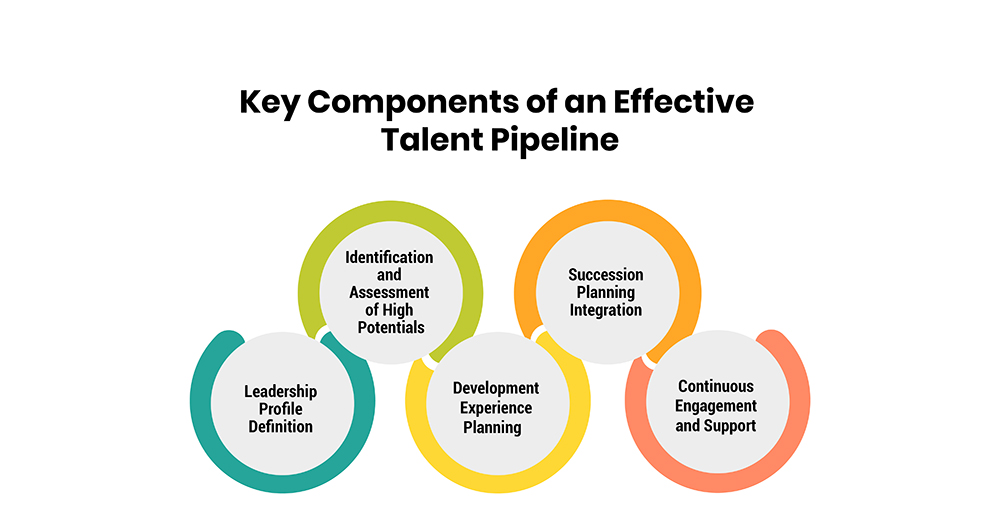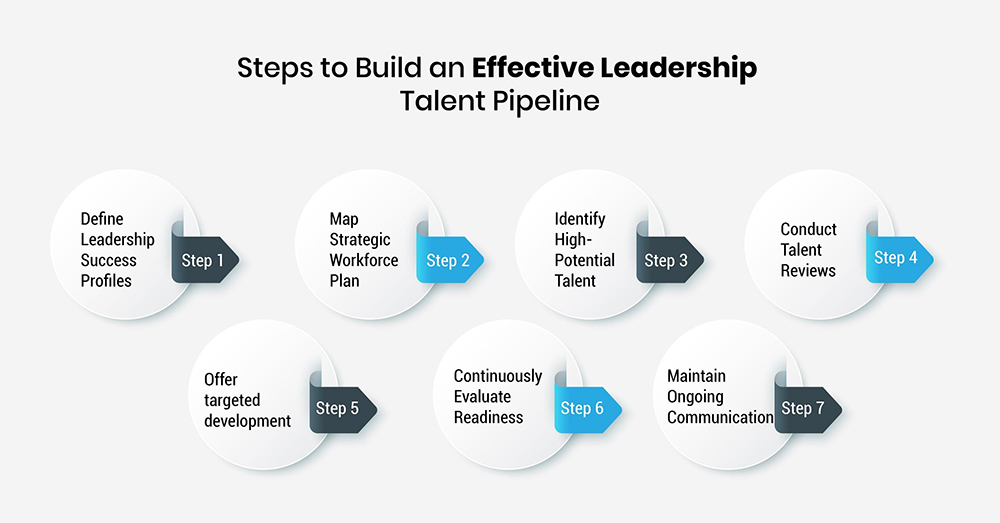
As the pace of business continues to accelerate, having a steady stream of talented, skilled leaders ready to step into new roles has become a necessity for any successful organization. However, for many companies, leadership development is still an afterthought rather than a strategic priority. By taking a proactive approach to talent management and implementing a formal talent pipeline strategy, businesses can future-proof their leadership needs and gain a competitive edge.
This article will explore how to develop a robust talent pipeline focused on cultivating future leaders from within. We'll look at the key components of an effective pipeline model, strategies for identifying high-potential individuals, and approaches for providing the support and development opportunities that allow internal talent to realize their leadership potential. With the right talent pipeline in place, companies can ensure a steady supply of skilled managers and executives who are perfectly equipped to guide the organization through its next phase of growth and change.
What is a Talent Pipeline?
A talent pipeline refers to the process of actively grooming internal candidates to fill future leadership needs within an organization. Rather than relying solely on external hiring to fill key roles, an optimally functioning talent pipeline focuses on nurturing, assessing, and developing existing high-performing employees who demonstrate leadership potential.
The goal is to have a continuous flow of qualified candidates progressing through various stages of leadership readiness. Some individuals may be early in their development journey and years away from senior roles, while others are nearing the final stage and prime for more significant responsibilities. By planning strategically and making talent a priority, companies can minimize disruption from turnover and have leaders equipped to step seamlessly into new challenging roles.
Benefits of Developing a Strong Talent Pipeline
Setting up a robust talent pipeline framework delivers significant benefits that boost organizational performance and sustainability over the long run:
-
Ensures leadership continuity as roles undergo natural transition. When leaders retire or move on, having internal candidates ready to step up prevents business disruption.
-
Reduces expensive external hiring by nurturing talent from within. Outside recruitment is costly and risky compared to developing known internal potential.
-
Improves employee engagement and morale. Demonstrating clear paths for growth motivates high performers to stay, invest in developing their skills, and advance their careers within the company.
-
Transfers institutional knowledge seamlessly. Promoting from within supports a smooth leadership handover with a new incumbent already familiar with business operations and culture.
-
Futureproofs the organization as markets evolve. An adaptable pipeline keeps the leadership talent pool aligned with changing strategic needs to drive business success for years ahead.
Key Components of an Effective Talent Pipeline
With an understanding of the pipeline concept and its benefits established, let's examine the essential elements that structure and optimize the process:

-
Leadership Profile Definition
To systematically identify leadership potential, organizations must first clearly outline the skills, qualifications, experiences, and aptitudes required for various leadership levels. With a leadership profile in place, talent scouts can apply objective criteria when assessing candidates.
-
Identification and Assessment of High Potentials
Formal processes like multi-rater feedback tools, psychometric evaluations, and structured interviews help pinpoint top performers exhibiting leadership competencies. Ongoing assessment tracks an individual's growth readiness and fit over time.
-
Development Experience Planning
Customized development roadmaps guide high potentials through targeted learning interventions such as stretch assignments, coaching, mentorship, coursework and skills workshops aligned with their leadership profile.
-
Succession Planning Integration
Strategic long-term planning ensures critical leadership vacancies can be smoothly filled. The pipeline integrates with business priorities to supply roles driving future goals.
-
Continuous Engagement and Support
Motivating future leaders requires ongoing advocacy, resources, goal setting and reviews to steward candidates along their development journey.
Effective talent pipelines also incorporate administrative aspects like data management systems to track pipeline metrics, costs, and program ROI over the long haul. With these core components addressed, organizations can actualize their leadership potential.
Identifying High-Potential Talent
No pipeline can flow without a supply of candidates demonstrating strong leadership acumen and future-leader proclivities. Spotting these potentials requires casting a wide analytical net:
-
Look for Stellar Performance
While individual contributions alone don't guarantee leadership skills, exceptional achievement shows competencies like drive, ownership and initiative prized in managers. Consistent top performance warrants closer examination.
-
Assess Interpersonal Skills
Leaders are ultimate team players, so seek feedback on soft talents like communication, collaboration, mentorship, conflict management and emotional intelligence when engaging others. Beyond technical merit, how well do peers respond?
-
Gauge Adaptability and Change-Agility
Thriving in VUCA environments demands embracing ambiguity and evolution. How do candidates handle uncertainty, learn quickly and navigate change? Do they energize others through times of flux?
-
Consider Breadth of Experience
Diverse, cross-functional stints help round out business acumen. Look for professionals enriching their impact by developing new competencies and expanding their networks over time.
-
Recognize Passion for Self-Development
Leaders steer continuous growth - their own as well as others'. Candidates proactively enlarging their skills base via conferences, further education and independent research demonstrate the right mindset.
-
Leverage Assessment Tools Wisely
Tests like 360 reviews, simulative exercises, and structured situational interviews can offer objective insights where biases may cloud judgment if relied upon solely. But they still require seasoned analysis versus overreliance on impersonal scores alone.
High-Potential Development Strategies
With top talent now identified, structured development planning equips these potentials to progressively expand their leadership impact:
-
Stretch Assignments
New, elevated scope challenges candidates outside their comfort zones, deepening exposure. Temporary roles, projects with broader remit or rotational job swaps can stretch leaders-in-training.
-
Mentorship Programs
Pairing high potential with experienced mentors allows for guidance, counsel and sponsorship. Set clear expectations, then track learnings on both sides.
-
Targeted Training
Micro-credential programs focused on interpersonal, strategic, organizational or technical leadership skills that complement on-the-job experiences. Combine actions with principles.
-
Global Immersion
Whether short-term international assignments or periodic overseas trips, global exposure broadens perspectives on varied challenges and best practices. Great for those steering multinational teams.
-
Coaching Circles
Regular coaching groups for psychosocial and career support between peers and a facilitator. Leaders advise each other through difficult discussions and decisions.
-
Succession Positioning
Guiding emerging leaders through strategic projects that allow visibility across executive ranks. They prove their senior leadership investment case while gaining exposure.
How to Build an Effective Leadership Talent Pipeline
An effective leadership pipeline involves careful definition, planning, identification, development and evaluation of high-potential talent over time. The following steps will help you build a talent pipeline:

-
Step 1) Define Leadership Success Profiles
The first step is to define clear leadership success profiles for key roles. Organizations should clarify the ideal qualifications, competencies, experiences and attributes expected of leaders occupying distinct positions that drive business goals.
It is important to benchmark current high-performing leaders holding such roles to objectively identify the criteria that makes them successful. This includes their educational qualifications, functional and leadership experiences, demonstrated track record as well as behavioral traits like communication skills, strategic thinking, collaboration and mentoring abilities. Documenting these leadership success criteria establishes transparency around what it takes to advance within the organization.
-
Step 2) Map Strategic Workforce Plan
Once leadership success profiles are defined, the next step involves long-term strategic workforce planning to understand leadership demand and supply. Organizations must analyze succession timelines based on factors like retirement forecasts, surveys of career plans, existing skills and demographics within the workforce. This allows prioritizing roles or business units where future gaps are anticipated due to attrition of existing leaders. Workforce analytics helps align the leadership pipeline with organizational needs both in the short and long run.
-
Step 3) Identify High-Potential Talent
With leadership criteria established, the talent identification process can commence. High-potential talent is spotted by leveraging multiple sources including performance appraisals, feedback from managers and psychometric assessments that measure competencies outlined in leadership success profiles.
The assessments could evaluate capabilities like decision-making, team leadership, resilience and ability to adapt to change. Individuals consistently exceeding expectations and demonstrating stronger potential should be considered for the leadership pipeline.
-
Step 4) Conduct Talent Reviews
Regular talent reviews involving HR, business leaders and candidates themselves ensure continued development and tracking of progress. During the reviews, candid developmental feedback is provided while expectations are clearly established through personalized development planning. Both managers and candidates are accountable for delivery against the goals in a time-bound manner. Formal and informal mentoring further strengthens the relationship between leaders and high-potentials.
-
Step 5) Offer targeted development
Targeted development interventions are crucial for honing the leadership capabilities identified as essential for success profiles and overcoming weaknesses. Examples include special work assignments, secondments, coaching and mentoring, rotational programs, participation in communities of practice, formal training and executive education. Key is exposing candidates to diverse experiences and challenges through a blended program tailored to their needs.
-
Step 6) Continuously Evaluate Readiness
Periodic evaluations help assess increasing readiness for greater responsibilities over time. Structured interviews and assessments at planned milestones gauge development against defined criteria. Candidates demonstrating strong progress through observations are primed for promotion or lateral moves into critical leadership roles. However, those unable to meet expectations despite additional support and time should be replaced to maintain pipeline integrity.
-
Step 7) Maintain Ongoing Communication
Finally, ongoing transparency and two-way communication boost commitment and motivation. Regular engagement activities and updates foster credibility in the organization’s intention to invest in individuals and their careers. This encourages retention of high-performers who see a clear path for progression. Collectively, these well-structured steps effectively nurture an internal stream of talent prepared to take on leadership of the future.
Supporting Talent Beyond Development
While learning activities promote leadership skill-building, talent risks fading without the incentives retaining talent their commitment:
-
Recognition and Reward Systems
Compensation benchmarked to market, bonuses, public commendations and non-monetary rewards motivate high potentials and signal their value.
-
Career Advancement Opportunities
With attractive next steps clearly mapped out, top contributors envision future growth within the ecosystem. Stagnancy only breeds disengagement.
-
Sponsorship and Advocacy
Executive allies advocate for potentials, champion their capabilities to broader networks internally and champion their case for bigger opportunities.
-
Psychosocial Support Structures
Events that deepen belonging through mentor mixers, industry conferences and cultural activities balance the stresses of leadership development journeys.
-
Ongoing Performance Feedback Loops
Regular check-ins calibrate development, air concerns and ensure pipelines remain dynamic rather than rigid bureaucratic processes devolving to checking box-ticking.
Together, a holistic approach that combines learning, mentorship, and career development empowers candidates to grow into stronger leaders, ultimately driving organizational success through their enhanced skills and leadership abilities.
Measuring Pipeline Success and ROI
Ultimately the proof lies in tangible leadership pipelines produced: how they strengthen business performance and benefit organizational health over the long run. Some metrics to track include:
-
Internal promotion rates indicating pipeline effectiveness.
-
Reduction in leadership vacancy durations with "pipeline hires".
-
Retention rates showcasing engagement among future leaders.
-
Diversity starts reflecting an inclusive pipeline that cultivates all talent.
-
Evaluation of leadership program ROI in hard financial outcomes.
-
Participant feedback and assessments measuring learning impact.
-
Tracking "high-potential retention" over 3-5 years indicates engagement.
-
Business metrics like productivity, quality, innovation linking to leadership.
Periodic calibration keeps pipelines optimally structured to maximize potential outcomes. With data-backed investment cases, leadership development gains integral support as a business-critical function.
Conclusion
Cultivating internal leadership yields a true competitive edge as the capable, experienced leaders of tomorrow continually emerge from within to steer future success. By establishing robust talent pipelines focused on future needs combined with holistic talent management, organizations can effectively future-proof their leadership supply for years to come.
Strong implementation at all levels will see tangible benefits across business performance, sustainability, and capability to navigate strategic change. Overall the pipeline’s long-term rewards make it a cornerstone talent strategy for any enterprise committed to continuously growing their leadership bench strength from within.




